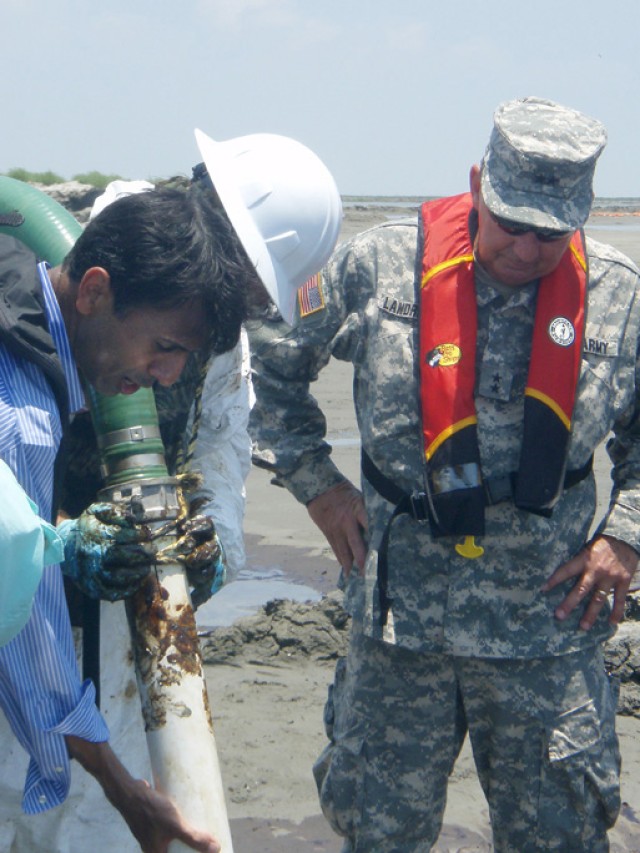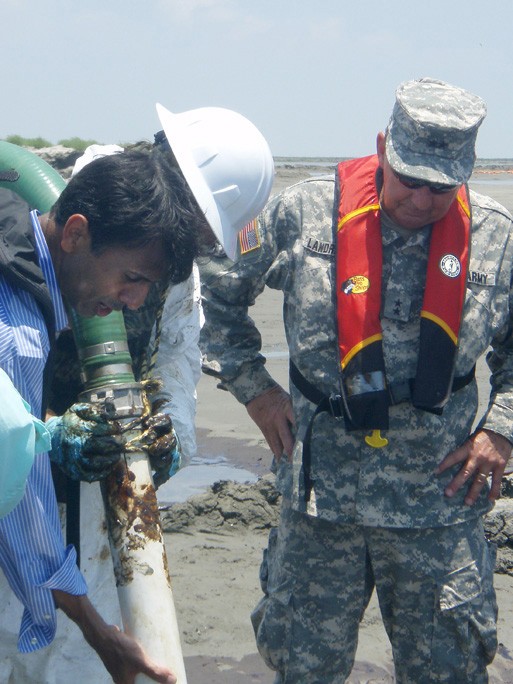BATON ROUGE, La. (Army News Service, June 11, 2010) -- The Louisiana National Guard received approval yesterday evening from the U.S. Coast Guard to field 10 additional vacuum barges, bringing the number approved to 13.
As demonstrated in operations at East Grand Terre Island, La., these vacuum barges are effective in removing oil from marsh and inland areas of Louisiana's coast. The two vacuum barges currently in operation, one composed of military float bridges and the other a civilian barge, are recovering about 1,000 gallons of oil each per day. To date, the barges have collected more than 6,400 gallons.
The newly approved vacuum barges will be placed in coordination with parish officials and the Coast Guard at locations in Plaquemines, Jefferson, Lafourche, St. Bernard and Terrebonne parishes. The need exists for more of these systems to remove oil from marsh areas as soon as spotting occurs.
The Louisiana Guard's approval to field the additional vacuum barges comes only days after its June 8 completion of a nearly month-long operation which repaired gaps caused by coastal erosion on Pelican Island in coastal Plaquemines Parish, La. The repairs were made by dropping large sandbags, ranging from 2,000 to 4,000 pounds each, from helicopters. Officials believe these efforts should help mitigate the impact of the oil spill that's approaching the Louisiana coastline.
Members of the 843rd Horizontal Company and the 2225th Multi-Role Bridge Company, 205th Engineer Battalion, filled the sandbags on the ground. The 1st Battalion, 244th Aviation Regiment airlifted the bags in place with UH-60 Blackhawk helicopters.
The 244th, with assistance from the Nebraska, Illinois, Missouri, Mississippi and Florida National Guards, flew about 243 flight hours in support of the mission.
The breaches ranged from 100- to 300-feet-wide each, and the mission took more than 3,300 sandbags to complete.
The Louisiana Guard also completed the construction of an almost six-mile long Tiger Dam shoreline-protection system near Venice, La., in the Southwest Pass of the Mississippi River Delta.
The 1023rd Vertical Engineer Co., headquartered in Oak Grove, La., constructed the barrier across a beach in the Southwest Pass as a secondary line of defense to the boom line, to protect the natural marshlands from the approaching oil.
The 1st Battalion of the 244th Aviation Regiment based in Hammond, La., airlifted Soldiers in and out of the worksite daily due to its remote location.
All of the inflatable barrier material and equipment had to be sling-loaded and dropped in place by the Black Hawks.
The water diversion system, normally used for flood control, replaces sandbags and is composed of a series of interlocking flexible tubes that are inflated with water to form a temporary dam or levee.
As work crews laid out the Tiger Dam material for assembly and inflation, other crews worked pumps to fill water into tubular sections.
Once completed, the 1023rd worked with the Florida National Guard's 2nd Battalion, 111th Aviation Regiment, to transport equipment from Southwest Pass to Venice for cleaning and maintenance.
The newly approved vacuum barges will be placed in coordination with parish officials and the Coast Guard at locations in Plaquemines, Jefferson, Lafourche, St. Bernard and Terrebonne parishes.
The need exists for more of these systems to remove oil from marsh areas as soon as spotting occurs, officials said.


Social Sharing